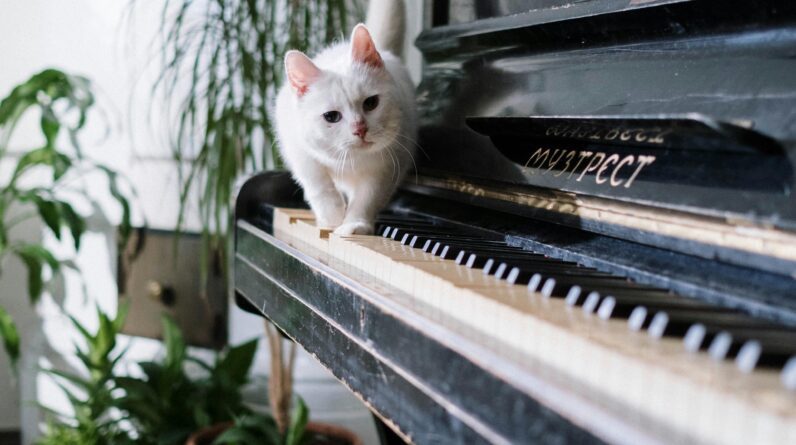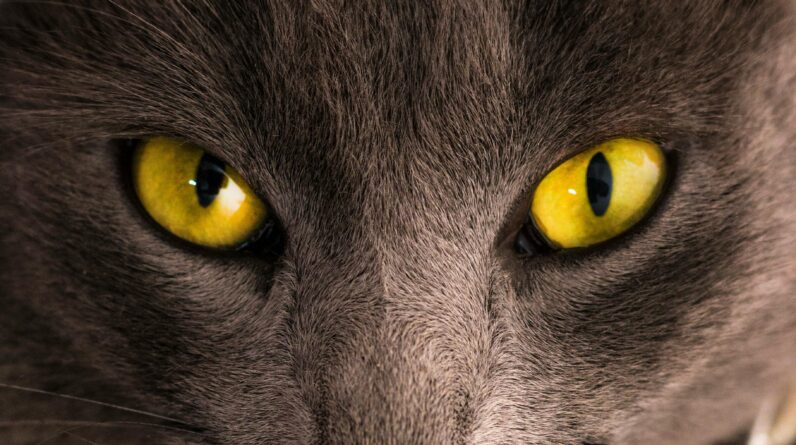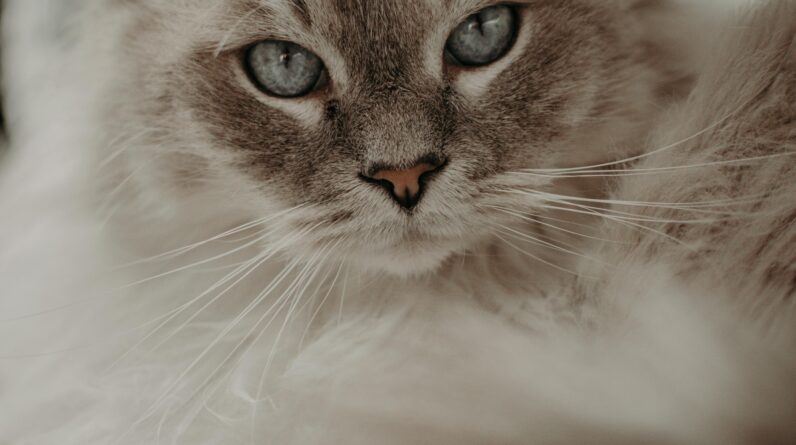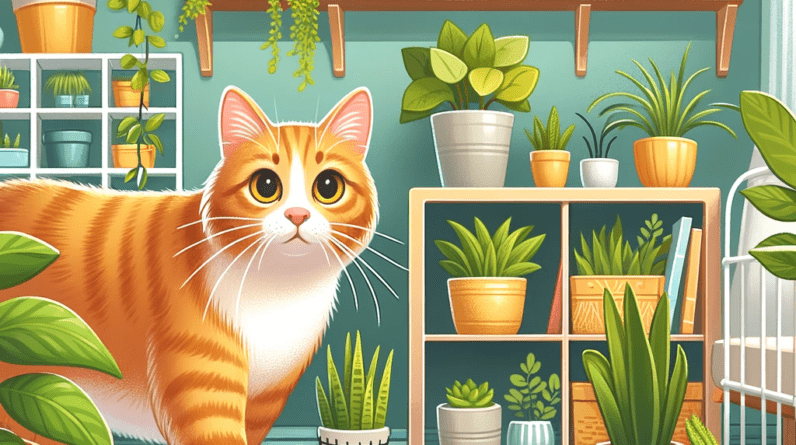
Keeping Your Ginger Cat Safe: A Guide to Dangerous Houseplants
As a loving cat owner, ensuring the safety of your ginger cat is paramount.
While these vibrant felines bring joy and companionship, certain common houseplants can pose hidden dangers.
This guide aims to inform you about harmful houseplants to keep your ginger cat healthy and safe.
Key Takeaways:
- Identify Risky Plants: Learn which houseplants are toxic to ginger cats.
- Create a Safe Space: Ensure your home is safe by removing or securing hazardous plants.
- Opt for Safe Greenery: Choose non-toxic plants like cat grass or catnip for your home.
- Stay Vigilant: Watch for signs of plant poisoning in your cat, such as vomiting or unusual lethargy.
- Seek Expert Advice: Consult with veterinarians or plant specialists for guidance on pet-safe plants.
- Act Quickly in Emergencies: If your cat ingests a toxic plant, contact your vet immediately.
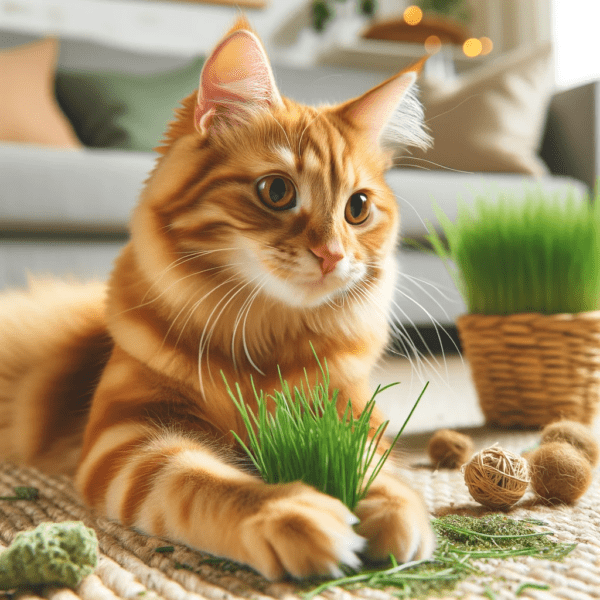

Why Ginger Cats Are at Risk
Ginger cats, with their striking orange fur, share a common trait with all felines: curiosity.
This inquisitive nature often leads them to explore and sometimes taste the greenery in their environment.
Their habit of nibbling on plants can be more than just a nuisance.
It poses a real risk if the plant in question is toxic.
Interestingly, the vibrant coat of ginger cats doesn’t make them more vulnerable to plant toxins than other cats.
However, their behavior does.
All cats use their mouths to investigate objects.
This behavior increases the risk of ingesting harmful plant parts.
It’s important to note that cats lack the ability to detect many toxic substances in plants.
Their bodies can react severely to certain chemicals found in common household foliage.
Symptoms of poisoning can range from mild, like drooling, to severe, including kidney failure or worse.
While there’s no specific evidence suggesting that ginger cats are uniquely at risk, the danger is universal for all feline breeds.
Every cat owner, regardless of their pet’s color or breed, needs to be aware of the potential hazards posed by certain houseplants.
Understanding this risk is the first step in creating a safer environment for these beloved pets.


Common Dangerous Houseplants
Lilies (Lilium spp. and Hemerocallis spp.)
Lilies are extremely dangerous for cats.
Even a small bite can be harmful.
They cause kidney failure in cats.
Symptoms might not show up right away.
Keep all types of lilies away from your cats.
Aloe Vera
Aloe Vera is great for people but not for cats.
Cats can also have diarrhea after eating it.
This can lead to dehydration.
Be careful with Aloe Vera plants in your home.
Pothos (Epipremnum aureum)
Pothos is a common houseplant.
It’s also known as Devil’s Ivy.
Cats chewing on this plant will feel a burning sensation.
They might have trouble swallowing. Vomiting is also a common reaction.
Asparagus Fern
This plant might look harmless but it’s not safe for cats.
It causes skin rashes, known as allergic dermatitis.
Cats eating this plant can get stomach upsets. They might vomit or have diarrhea.
Daffodils
Daffodils are especially toxic.
Their bulbs are the most dangerous part.
If a cat eats them, they will vomit.
They can also have diarrhea. In severe cases, it can lead to more serious health issues.
Philodendron
Philodendron plants are popular but risky for cats.
They have a chemical that irritates the mouth.
Cats will drool and feel pain.
Vomiting is also a common symptom. Keep these plants out of reach.
While these plants add beauty to your home, they pose significant risks to your ginger cat.
If you suspect your cat has ingested any part of these plants, contact your vet immediately.
It’s always better to be cautious and keep these plants out of your cat’s reach.
| Plant | Effects on Cats |
|---|---|
| Lilies (Lilium spp. and Hemerocallis spp.)
| Highly toxic, even in small amounts. Can cause kidney failure. |
| Aloe Vera
| Causes vomiting and diarrhea. Can lead to dehydration. |
| Pothos (Epipremnum aureum)
| Causes oral irritation, difficulty swallowing, and vomiting. |
| Asparagus Fern
| Can cause allergic dermatitis and gastrointestinal upset. |
| Daffodils
| Bulbs are particularly toxic, causing vomiting, diarrhea, and more severe symptoms. |
| Philodendron
| Contains insoluble calcium oxalates, leading to oral irritation, drooling, vomiting. |
| Snake Plant
| Can cause nausea, vomiting, and diarrhea. |
| Dieffenbachia
| Irritates the mouth, tongue, and lips, leading to difficulty swallowing and vomiting. |
| Sago Palm
| Extremely toxic, can cause liver failure and potentially death. |
| Tulips
| The bulb is highly toxic, causing oral irritation, drooling, and gastrointestinal upset. |
| Oleander
| Highly poisonous, can cause severe vomiting, diarrhea, and cardiac issues. |
How to Keep Your Ginger Cat Safe
Know Your Plants
It’s essential to be aware of all the plants in your home.
Not all plants are safe for cats.
Make a list of your houseplants.
Research each plant to see if it’s safe for cats.
If you’re not sure about a plant, ask an expert.
Experts can be plant nurseries or veterinarians. Remember, the safety of your cat comes first.
Keep Plants Out of Reach
Cats can be very agile and curious.
Place harmful plants where your cat can’t reach them.
High shelves or closed rooms are good options.
Always keep an eye on your cat.
If you see them near dangerous plants, move the plants or the cat. Prevention is better than cure.
Opt for Cat-Safe Plants
Choose plants that are safe for cats.
Cat grass and catnip are great options.
These plants can be fun and healthy for your cat.
They can chew on these plants without any risk.
Having cat-safe plants keeps your cat entertained and safe.
Watch for Symptoms
Be vigilant for signs of poisoning.
Common symptoms include vomiting and diarrhea.
Lethargy or unusual behavior is also a warning sign.
If you notice these symptoms, act quickly.
Contact your vet immediately. Early treatment can make a big difference.
By following these guidelines, you can create a safer environment for your ginger cat.
It helps prevent accidents and ensures your cat’s wellbeing.
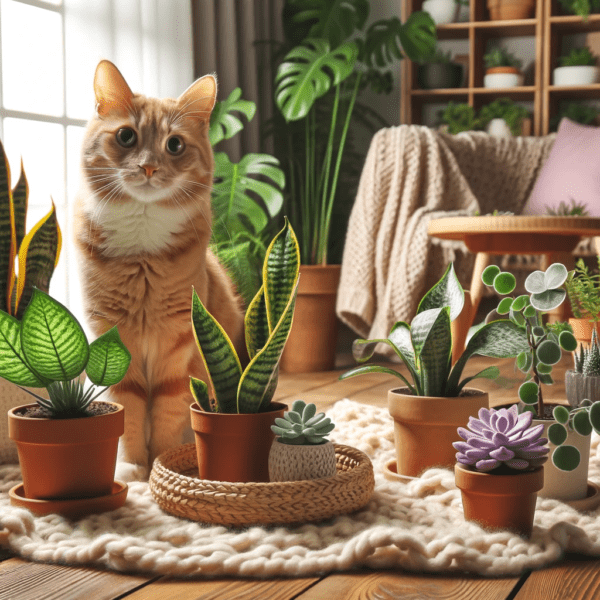

Signs of Poisoning in Cats
Recognizing the signs of plant poisoning in cats is crucial for their wellbeing.
If you have houseplants, be aware of these common symptoms.
Vomiting and Diarrhea: These are the most common signs and can occur shortly after ingestion.
Lethargy: A noticeable decrease in energy or excessive sleepiness can be a sign of poisoning.
Loss of Appetite: Refusing to eat is a concerning symptom that shouldn’t be ignored.
Drooling or Pawing at the Mouth: This indicates oral irritation, a common response to toxic plants.
Difficulty Breathing: If the cat is struggling to breathe, it’s a sign of a severe reaction and requires immediate veterinary attention.
Pet-Friendly Plants
When it comes to creating a safe environment for your ginger cat, choosing pet-friendly plants is essential.
Here are some popular options that are both safe and appealing.
Cat Grass: Specifically grown for cats, cat grass is safe and can aid their digestion.
Spider Plant: Non-toxic to cats, spider plants are easy to care for and can tolerate a variety of conditions.
Boston Fern: This plant is safe for cats and adds a lush, green touch to your home.
Bamboo: Bamboo plants are safe for cats and can add an exotic flair to your living space.
African Violet: Known for their beautiful flowers, these plants are safe and can brighten up any room.
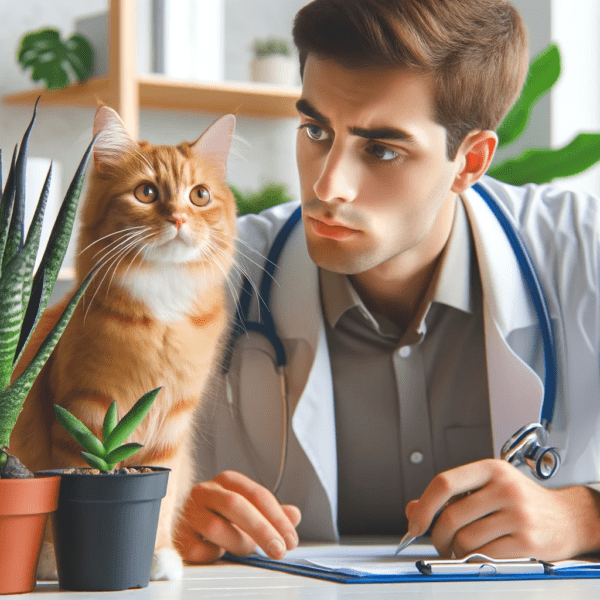

Safe Home Environment
Creating a safe home environment for your ginger cat, especially when it comes to houseplants, is crucial for their well-being.
Plant Placement and Safety
Elevate Harmful Plants: Keep any potentially toxic plants out of reach. High shelves or hanging planters can be effective.
Secure Planters: Ensure that planters are stable and can’t be knocked over by a curious cat. Cats love to climb and explore, so securing planters helps prevent accidents.
Cat-Friendly Plant Choices
Opt for Safe Plants: As mentioned, choose plants that are known to be safe for cats.
This includes cat grass, spider plants, and Boston ferns.
Avoid Toxic Plants: Be vigilant about not bringing plants like lilies, poinsettias, or aloe vera into your home, as they can be toxic to cats.
Regular Monitoring and Maintenance
Check Plants Regularly: Inspect your plants for signs of nibbling or cat interference.
Maintain Cleanliness: Keep the area around plants clean to avoid attracting your cat with fallen leaves or soil.
Cat-Proofing Measures
Use Bitter Apple Spray: Some cat owners find that using a bitter apple spray on plants deters cats from chewing on them.
Provide Alternatives: Offer your cat safe alternatives to explore and play with, like cat toys or a dedicated cat grass planter.
Awareness and Education
Stay Informed: Keep up-to-date with information on which plants are safe or harmful to cats.
Educate Household Members: Make sure everyone in the household knows which plants are off-limits to the cat.
By taking these steps, you can create a living space that is both beautiful and safe for your ginger cat.
This proactive approach ensures that your feline friend can enjoy a healthy and happy life in your shared home environment.
Protecting your ginger cat from harmful houseplants is an essential aspect of responsible pet ownership.
By being informed and vigilant, you can ensure your furry friend enjoys a safe, happy, and healthy life in your loving home.
FAQs:
Q: Are all lilies dangerous to ginger cats?
A: Yes, all lilies are extremely toxic to cats, including ginger cats.
Even a small amount can cause kidney failure.
Q: Can ginger cats safely eat any houseplants?
A: While ginger cats may enjoy nibbling on plants, it’s safest to provide them with cat-friendly options like cat grass or catnip, which are non-toxic.
Q: What should I do if my ginger cat ingests a toxic plant?
A: If you suspect your cat has ingested a toxic plant, contact your veterinarian immediately.
Quick action is crucial for their health.
Q: How can I tell if a plant is safe for my cat?
A: Research each plant in your home or consult a plant expert.
There are also many online resources and apps available to help identify safe plants.
Q: Are symptoms of plant poisoning immediate in cats?
A: Symptoms can vary; some may appear immediately, while others might take time to develop.
Always monitor your cat closely after suspected ingestion.
Q: Can I keep toxic plants if they are out of my cat’s reach?
A: Keeping toxic plants out of reach can reduce risk, but it’s not foolproof.
Cats are skilled climbers and may find a way to access them.
Q: Is it necessary to get rid of all potentially dangerous plants?
A: While removing toxic plants is the safest option, if you choose to keep them, ensure they are completely inaccessible to your ginger cat.




